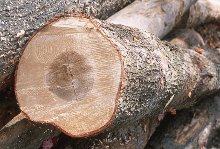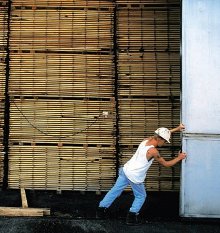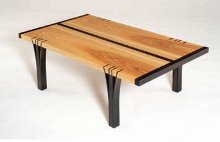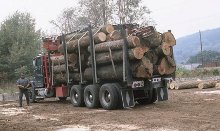Putting LCA at the centre of sustainable design
18 August 2012AHEC has published a comprehensive report on the environmental life cycle of delivering US hardwood lumber into overseas markets. The ISO-conforming report has received praise from independent LCA experts and is being used as the basis for innovative tools to integrate sustainability into product design. Rupert Oliver reports
If sustainability is ever to become more than a mere aspiration in design, manufacturing and construction, decisions need to be made based on hard facts. New tools are needed which bring in data from numerous sources covering a huge range of environmental impacts. These tools must be flexible enough to accommodate widely different materials and contexts, and yet accessible so that environmental information can be readily integrated into the design process without adding excess cost.
That's a very tall order - but a widening range of scientists, industry groups, specifiers, government and consumer interests has been chipping away at the problem for several years. Their efforts are beginning to show results. Central to this process has been the development of life cycle assessment (LCA), a scientific method involving collection and evaluation of quantitative data on all the inputs and outputs of material, energy and waste flows associated with a product over its entire life cycle so that the environmental impacts can be determined.
The LCA process is now covered by international standards, the ISO 14040 series, to ensure results are scientifically rigorous and not subject to manipulation by different industrial sectors. The standards require, for example, that data collection and analysis is undertaken by independent third parties and subject to critical review by a panel of independent experts.
The American Hardwood Export Council (AHEC), which represents the interests of exporters of hardwood lumber and veneer from the US, is actively promoting an LCA-based approach to sustainable material use and design to help overcome widespread misconceptions about the environmental credentials of hardwood products. It is often assumed, for example, that because hardwoods are usually derived from managed natural forests and "slow to grow", their use contributes to forest degradation or deforestation.
Another common assumption in Europe is that because American hardwoods have to be transported across the Atlantic, they must have a higher carbon footprint than locally produced materials.
This led AHEC to embark on a comprehensive LCA project with two major objectives: first, to ensure full conformance to ISO 14040 to ensure the credibility of the data; and second, to ensure that the LCA data is made available in such a form that it is useful to decision-makers in material specification and product design.
Independent company PE International was engaged to undertake the work due to its experience of LCA in a range of business sectors and its ability to offer innovative LCA tools. These include PE's proprietary Gabi software, which facilitates collection and analysis of LCA data, and an "i-report" system to make this data accessible and useable by designers and manufacturers. PE has also been heavily engaged in efforts to develop a global standardised framework for reporting LCA data in Environmental Product Declarations (EPDs).
Critical Review Panel
At the start of the process, AHEC and PE International assembled a high-powered Critical Review Panel chaired by Dr Matthias Finkbeiner, a professor at Berlin University who also chairs the ISO committee developing international LCA standards. By involving the panel in the project early on, rather than simply seeking their endorsement at the end, methodological issues could be dealt with as they arose. When the final LCA report was published in July, the panel not only confirmed its compliance to the ISO standard, but also "found the overall quality of the methodology and its execution to be excellent".
The report provides a comprehensive analysis of US hardwood lumber's profile across a wide range of environmental impacts. In technical terms it is a "cradle-to-gate plus transport" study, covering all impacts associated with extracting the wood in the forest, transporting, sawing and kiln drying the material in the US, and then delivering the lumber to the importers' yard in major overseas markets.
The report includes a qualitative assessment of land use and land use change, biodiversity, water resource and toxicity impacts associated with supply of US hardwood lumber, indicating very low environmental impact across all these categories. On land use change, it observes "in the system under investigation the main material - wood - comes from naturally regrown forests. The harvested areas had undergone several iterations of harvesting and regrowth. After harvesting, the land is returned to forest so there is no direct land use change to account for in the timeline of a few hundred years".
On biodiversity impacts, the study concludes that: "Conversion of any other commercial land into the hardwood forest would most probably be a positive impact on the land quality, including biodiversity and associated ecosystem services". On toxicity it notes that: "In the production of hardwood lumber there are no fertilisers or wood treatment chemicals or any other known substances of particular toxicity concern". On water resources it comments: "hardwood lumber is expected to have very low impacts".
Numerical data
While some impacts are treated qualitatively in the LCA report, others are dealt with quantitatively. The report provides numerical data on Global Warming Potential (GWP - better known as carbon footprint), Acidification Potential (AP), Eutrophication Potential (EP), Photochemical Ozone Creation Potential (POCP), and Ozone Depletion Potential (ODP). It also identifies which processes along the supply chain (forestry, sawing, kilning, transport) are most important in determining each of these impacts. It includes a sensitivity analysis to show how environmental impacts vary according to key factors such as species, lumber thickness, and transport distance and mode.
A key conclusion from this number crunching is that variation in environmental profile is at least as dependent on species and thickness as it is on transport factors. Providing average results for "sawn hardwood lumber" can be very misleading and data needs to be reported separately for each individual hardwood species and board thickness. This is mainly because kiln drying consumes a surprisingly large share of the energy needed to produce and deliver hardwood lumber. The time lumber spends in the kiln also varies widely between species and by thickness. For example, for 1in lumber, oak typically needs to be kilned at least three times longer than tulipwood. And 3in lumber requires more than four times as long in the kiln as 1in lumber.
Kiln drying and transport
While kiln drying has more of an impact than might be expected, the global warming impact of transport is less. Even very large changes in transport distance result in relatively minor changes in carbon dioxide emissions. For example, for 1in white oak lumber, the carbon footprint of delivering into London (shipping distance 720km by road and 6,300km by sea) is little different from that of delivering into central Poland (1,265km by road, 7,735km by sea). Even transporting lumber all the way from the eastern US to Australia, via Suez and Singapore (2,205km by road, 25,000km by sea), results in a carbon footprint no more than 50% greater than that of delivery into the UK.
As with all wood products, close to 50% of the dry mass of US hardwood lumber comprises carbon, which has been absorbed as the tree grows. In fact, the data gathered by PE shows that the amount of carbon stored in US hardwood lumber almost always exceeds the emissions required to extract, process and transport that lumber into any export market worldwide. However, all the above observations about carbon footprint ignore this storage benefit of the lumber. That's because the scope of this particular LCA report is restricted in that it ends at the point of delivery unavoidable since it's not possible for producers to know how their material will be used. Treatments, fixings, further processing, life span and method of disposal all have an influence on carbon storage. These need to be fully accounted for in future cradle-to-grave studies of manufactured products containing US hardwood - before it is appropriate to make far-reaching claims about the "carbon neutrality" of the raw material.
The AHEC study facilitates this next step by providing conservative estimates of the amount of carbon stored in US hardwood lumber products. This treatment of the carbon properties of wood products, which aligns with international best practice, was singled out for particular praise by the Critical Review Panel.
"Another commendable aspect of the study is the conservative approach taken with regard to modelling biogenic carbon removals from the atmosphere," it said. "The study quantifies the biogenic carbon uptake in forestry, and reports this separately from the cradle-to-gate result. This transparent and unbiased treatment of the biogenic carbon issue supports proper use of the data for future assessments of the complete life cycle of American hardwood-based products."
Carbon storage
The data provided on carbon storage in US hardwoods again highlights that there are significant variations between US species which need to be taken into account during the design process. Denser species like oak and hickory store more carbon per cubic metre than less dense species like tulipwood and willow.
The next stage of the project, and the most challenging, aims to integrate life cycle thinking into all stages in the design, manufacturing and delivery of products containing US hardwoods. As a first step, the LCA data for US hardwood lumber is being made available to suppliers and specifiers by way of PE's online i-report tool - this enables specific data to be generated for individual species, lumber thickness, processing parameters (such as kiln efficiency and energy sources), transport distances and modes (truck, ship, rail). AHEC is also commissioning preparation of formal EPDs in line with various national EPD programmes including BRE's Environmental Profiles. The LCA data will soon be introduced into AHEC's existing technical species guides and project case studies, which have long provided guidance and inspiration for use of American hardwoods in construction, interiors and furniture manufacturing.
However, perhaps the most innovative of AHEC's initiatives is a joint project ongoing with PE and the Royal College of Art in London to develop an i-report system for furniture designers. For the first time, this project will allow furniture designers to develop genuine understanding of the real and very direct environmental impact of their decisions when using US hardwoods.



